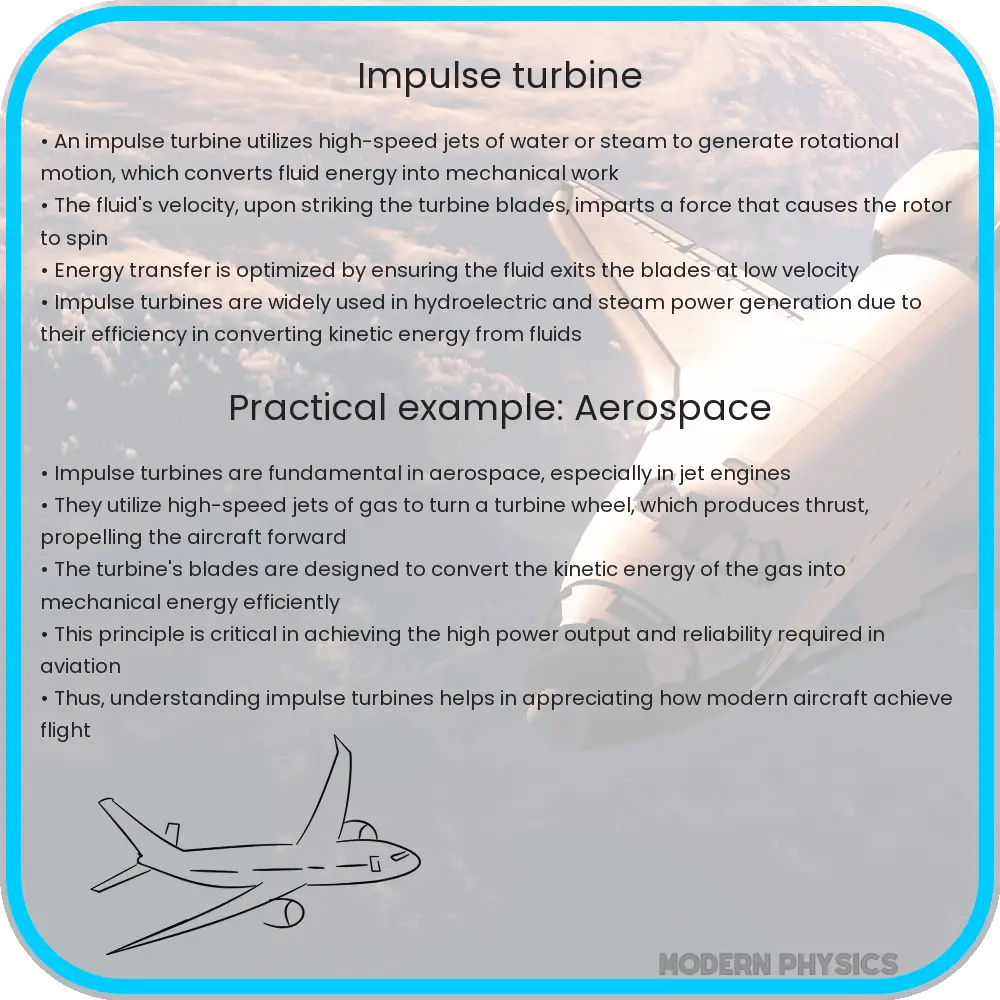Explore the efficiency, design, and fluid dynamics of impulse turbines, delving into their environmental impact and technological advancements.

Understanding Impulse Turbines: Efficiency, Design, and Fluid Dynamics
An Impulse Turbine operates on the principle of converting the kinetic energy of a jet of fluid into mechanical work. Unlike reaction turbines, where both pressure and kinetic energy are used, impulse turbines utilize only the kinetic energy of the fluid. This distinction is crucial in understanding their design and efficiency.
Efficiency of Impulse Turbines
The efficiency of an impulse turbine is predominantly determined by how effectively it converts the kinetic energy of the fluid into mechanical energy. One key factor is the velocity diagram of the fluid, which shows the fluid’s velocity before and after hitting the turbine blades. The ideal efficiency of an impulse turbine, denoted as η, can be mathematically expressed as:
\[ η = \frac{Actual Work Output}{Maximum Possible Work Output} \]
This efficiency is also influenced by factors like friction losses, blade design, and the velocity of the fluid jets.
Design Considerations
Designing an impulse turbine involves optimizing the shape and angle of the blades to maximize energy conversion. The bucket-shaped blades are a hallmark of impulse turbines, designed to change the direction of the fluid jet, thereby creating a mechanical force that drives the turbine. The nozzle, which converts pressure energy into kinetic energy, is another critical component. Its design ensures the jet is directed accurately onto the turbine blades.
Fluid Dynamics in Impulse Turbines
Understanding fluid dynamics is essential for the efficient operation of impulse turbines. The interaction between the fluid jet and the turbine blades involves complex flow patterns. The velocity and pressure of the fluid at the inlet and outlet of the turbine are key parameters. The Reynolds Number, a dimensionless quantity, is often used to predict the flow regime in the turbine.
Additionally, the Bernoulli’s principle plays a significant role in the turbine’s operation. It relates the pressure, velocity, and height in the fluid flow and is crucial in designing the nozzle and the blade passages.
Overall, the design and efficiency of impulse turbines are deeply rooted in their ability to harness fluid dynamics effectively, making them a vital component in various industrial applications.
Advanced Aspects of Impulse Turbine Design
Advancements in impulse turbine technology focus on refining blade geometry and nozzle design to enhance efficiency. The utilization of computational fluid dynamics (CFD) enables engineers to simulate and optimize the flow patterns within the turbine, leading to improved performance. Additionally, the material selection for the turbine components plays a pivotal role in ensuring durability and resistance to wear and corrosion.
Applications and Limitations
Impulse turbines find their applications predominantly in areas where high-head, low-flow water sources are available, such as in small hydroelectric plants. They are preferred for their simplicity, reliability, and ease of maintenance. However, their suitability is limited in scenarios involving low-head or high-flow conditions, where reaction turbines are more efficient.
Environmental Impact
From an environmental standpoint, impulse turbines are considered eco-friendly when used in hydroelectric power generation. They contribute to sustainable energy production by harnessing renewable water sources, reducing the dependency on fossil fuels and lowering greenhouse gas emissions.
Innovations in Impulse Turbine Technology
Recent innovations in impulse turbine technology include the development of micro-turbines for use in small-scale hydroelectric power generation. These turbines are designed to operate efficiently even at low water flows, making them suitable for a wider range of applications. Additionally, integrating smart sensors and IoT technology in turbine systems has enabled real-time monitoring and predictive maintenance, further enhancing their efficiency and lifespan.
Conclusion
In conclusion, impulse turbines are a critical component in the field of energy generation, distinguished by their ability to efficiently convert the kinetic energy of fluids into mechanical work. Their design, deeply rooted in principles of fluid dynamics, has evolved through advances in technology and materials. While they have specific applications and limitations, their role in sustainable energy solutions cannot be overstated. As technology continues to advance, impulse turbines will undoubtedly play a significant role in meeting the world’s growing energy demands in an environmentally responsible manner.
